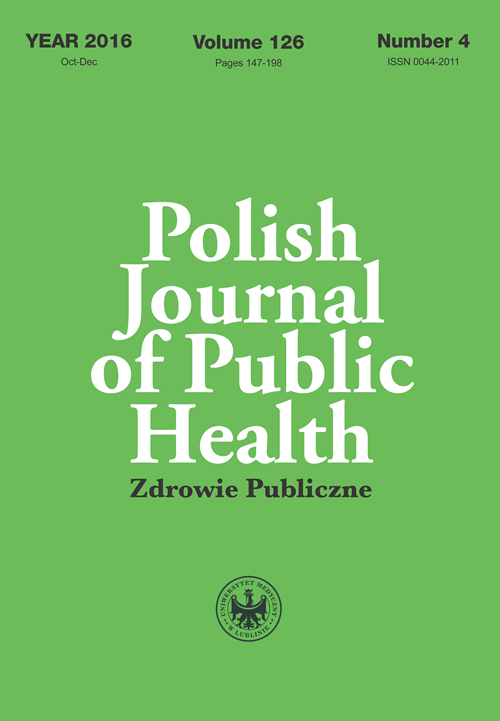Awareness of knowledge about the problem of human papillomavirus infections and HPV vaccination in a group of female students beginning their studies at universities in Lublin
DOI:
https://doi.org/10.1515/pjph-2016-0036Keywords:
HPV infections, cervical cancer, HPV vaccination, knowledge about HPVAbstract
Introduction. HPV infection is one of the most common type of sexually transmitted infections and it is a significant epidemiological problem all over the world. The risk of infection persistence and its progression to pathological, precancerous lesions depends on HPV type. Vaccinations against HPV virus are one of the elements of the prophylactic program and allow for early detection of cervical cancer.
Aim. Aim of the study was analysis of awareness of problems of human papillomavirus infections and cervical cancer prevention, including vaccinations against HPV among female students commencing studies in Lublin.
Material and methods. The research group included 400 women selected at random, all starting their studies at five universities in Lublin. The research group was supposed to show some general knowledge of the problem of cervical cancer among young women. It was also to define how many of them benefited from the prophylaxis of getting a vaccination against HPV. The scientific tool was individually elaborated survey questionnaire. Obtained study results were then subject to statistical analysis.
Results. The majority of respondents were not vaccinated against HPV – only 2.5% of the surveyed confirmed that they had been vaccinated. The surveyed students most frequently evaluated their knowledge on prevention of HPV cervical cancer as poor. The surveyed who admitted having information about HPV and cervical cancer prophylaxis during their classes at school significantly more frequently had high level of knowledge than women who claimed not to obtain such information at school (p=0.002).
Conclusions. It might make sense to conduct planned comparative studies in the centers practicing population vaccinations among girls aged 12-13 and not practicing such primary prophylaxis with cytological follow-ups. It may allow to elaborate the effective model of cervical cancer prophylaxis based on early educational activities, both on primary and secondary prophylaxis.
References
1. Rekomendacje Polskiego Towarzystwa Ginekologicznego dotyczące diagnostyki, profilaktyki i wczesnego wykrywania raka szyjki macicy Prz Menopauz. 2006;4:198-201.
2. Franco E, Villa L, Sobrinho J, et al. Epidemiology of acquisition and clearance of cervical human papillomavirus infection in women from a high-risk area for cervical cancer. J Infect Dis. 1999;180:1415-23.
3. Molano M, van der Brule A, Plummer M, et al. Determinants of clearance of human papillomavirus infections in Colombian women with normal cytology: a population-based, 5-year follow-up study. Am J Epidemiol. 2003;158:486-94.
4. Giuliano A, Harris R, Sedjo R, et al. Incidence, prevalence, and clearance of type-specific human papillomavirus infections: The Young Women’s Health Study. J Infect Dis. 2002;186:462-9.
5. Schiffman M, Kjær S. Natural history of anogenital human papillomavirus infection and neoplasia. J Natl Cancer Inst Monogr. 2003;31:14-9.
6. Schlecht N, Platt R, Duarte-Franco E, et al. Human papillomavirus infection and time to progression and regression of cervical intraepithelial neoplasia. J Natl Cancer Inst. 2003;95:1336-43.
7. [www.ecdc.europa.eu/en/publications/publications/20120905_gui_hpv_vaccine_updat.pdf]
8. Castle P, Wacholder S, Lorincz A, et al. A prospective study of high-grade cervical neoplasia risk among human papillomavirus-infected women. J Natl Cancer Inst. 2002;94:1406-14.
9. Workowski KA, Bolan GA. Centers for Disease Control and Prevention. Sexually transmitted diseases treatment guidelines, 2015. MMWR Recomm Rep. 2015;64(RR-03):84-93.
10. Charążka A, Bieńkiewicz A. Profilaktyka raka szyjki macicy w świadomości studentek. Zdr Publ. 2002;112:340-4.
11. Kotarski J, Basta A, Dębski R, et al. Rekomendacje Zespołu Ekspertów Polskiego Towarzystwa Ginekologicznego dotyczące szczepienia przeciwko zakażeniom HPV. Gin Pol. 2009;2:139-46.
12. Unger Z, Maitra A, Kohn J, et al. Knowledge of HPV and HPV vaccine among women ages 19 to 26. Womens Health Iss. 2015;S1049-3867(15)00078-X.
13. Almeida CM1, Tiro JA, Rodriguez MA, et al. Evaluating associations between sources of information, knowledge of the human papillomavirus, and human papillomavirus vaccine uptake for adult women in California. Vaccine. 2012;30:3003-8.
14. Johnson C, Aaronson N, Blazeby, et al. EORTC Quality of life group, Guidelines for Developing Questionnaire Modules, 4th editon; 2011.
15. Mastalerz-Migas A, Nowak A, Steciwko A. Wiedza i świadomość młodych kobiet w zakresie profilaktyki raka szyjki macicy. Fam Med Prim Care Rev. 2011;13(3):443-5.
16. Program profilaktyki zakażeń wirusem brodawczaka ludzkiego 2014-2016 r, Wydział Polityki Mieszkaniowej, Spraw Socjalnych i Zdrowia UM Kędzierzyn Koźle, załącznik nr 1 do Programu Ochrony Zdrowia 2014-2016; [www.kedzierzynkozle.pl/bip]
17. [www.lublin.eu/mieszkancy/zdrowie/programyzdrowotne/szczepienia-hpv]
18. Denny L, Herrero R, Levin C, et al. Cervical Cancer. In: H. Gelband, P. Jha, R. Sankaranarayanan, S. Horton (ed). Cancer: Disease Control Priorities, Third Edition (Volume 3). Washington (DC): The International Bank for Reconstruction and Development/The World Bank. 2015;4.
19. Podlińska M, Bernacka M, Gotlib J. Próba oceny wpływu wieku na poziom wiedzy na temat raka szyjki macicy wśród pacjentek hospitalizowanych w oddziale położniczo-ginekologicznym. Pielęg XXI w. 2010;1-2:57-63.
20. Saslow D, Runowicz CD, Solomon D, et al. American Cancer Society guideline for the early detection of cervical neoplasia and cancer. American Cancer Society. CA Cancer J Clin. 2002;52:342-62.
21. Reksa D, Muszyńska A, Grotowska M, et al. Rak szyjki macicy – profilaktyka a świadomość społeczna. Fam Med Prim Care Rev. 2006;8:740-2.
Downloads
Published
Issue
Section
License
Copyright (c) 2017 Polish Journal of Public Health

This work is licensed under a Creative Commons Attribution-NonCommercial-NoDerivatives 3.0 Unported License.


